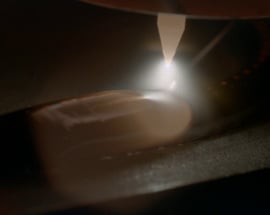Welding is not a very colorful operation. The metal, torch and other materials are usually varying shades of grey. The arc is bright white. The background is almost black. To accurately monitor and inspect welds, being able to see a massive tonal range, from the brightest to the darkest, is essential.
 |
 |
Color and Monochrome images of a TIG Welding Process
Standard cameras, and even the human eye, are incapable of distinguishing all features when faced with such a range of brightness. However, Xiris’ high dynamic range weld cameras can, either in color (the 1100 and 1100e) or black and white (the 1000 and 1000e).
As humans, we often think that color is better. But in weld cameras, that is not always the case. Determining whether a color or monochrome weld camera will work best depends on a company’s operations. Here are five questions to consider when choosing between color and monochrome weld camera:
1. What kind of welding process are you using?
TIG (GTAW) or Plasma welding benefit most from being viewed in color, simply because there is more color present in those welding processes. Evaluating the color of the torch tip, shielding gas, melt pool and even the Heat Affected Zone can help operators to assess the quality of the weld.
2. What do you want to monitor during welding?
For example, do you want to see certain features, such as the boundary between the end of the torch and the shielding gas and arc? That might help you closely monitor the integrity of the torch tip and avoid contamination.
Or, are you concerned about the amount or type of shielding gas in the process? The shielding gas can sometimes take on a unique color as it is consumed by the welding arc. Changes in the color can signify a change in the gas chemistry and alert operators to the possibility of impurities.
Or is the Heat Affected Zone (HAZ) of interest? The leading edge of the HAZ may become visible as the parent material colorizes at elevated temperatures. This can indicate the amount of heat penetration and energy transfer made during the welding process. Discoloration of the metal can signify the presence of excess heat.
3. Is color more important than resolution?
To generate a color image, the image sensor in the weld camera is “painted” with color filters. Each pixel becomes filtered with red, green or blue light in a standard pattern known as a Bayer pattern. The imaging software then mathematically recombines the pixels into a color image. One drawback of this process is that the resolution of a color image is decreased by approximately half compared to that of a monochrome image.
With higher resolution, monochrome cameras generate images with sharper detail than color cameras. In monochrome images, edges appear crisper and subtle details are more visible—important for assessing the texture of the melt pool, for example. However, the hues in a color image give the human eye the ability to better evaluate boundaries between various weld components, like the melt pool, torch tip and shielding gas.
4. Is camera speed important for your operation?
Despite being lower resolution, color image files are larger than monochrome because each pixel is described by 3 bytes of data, whereas in monochrome images, only 1 byte of data is required. As a result, a color camera often will transmit data slightly slower than a monochrome camera to its output device.
5. Does color provide additional information that can help your welding process?
Everyone’s welding operation is unique. You may have additional features such as guiding markers on your parent material, or wire being fed into the welding process that might be best suited to monochrome or color cameras. Our team can help you to assess your needs and advise whether color or monochrome will work best for your application.
Whatever the operational needs, Xiris’ weld cameras, in either monochrome or color, provide high contrast, clear images of the welding process, allowing manufacturers to quickly and easily monitor their welds for better process control.
For an article describing several of the common welding defects, click here..





.png)

